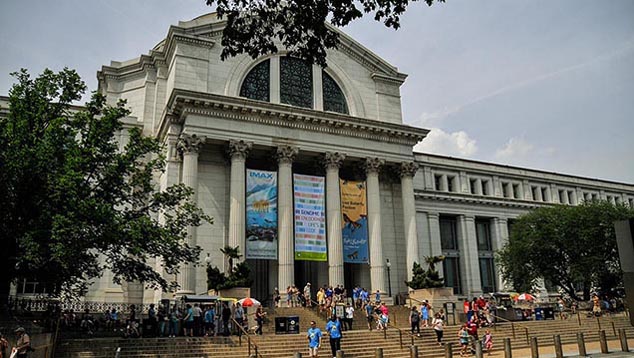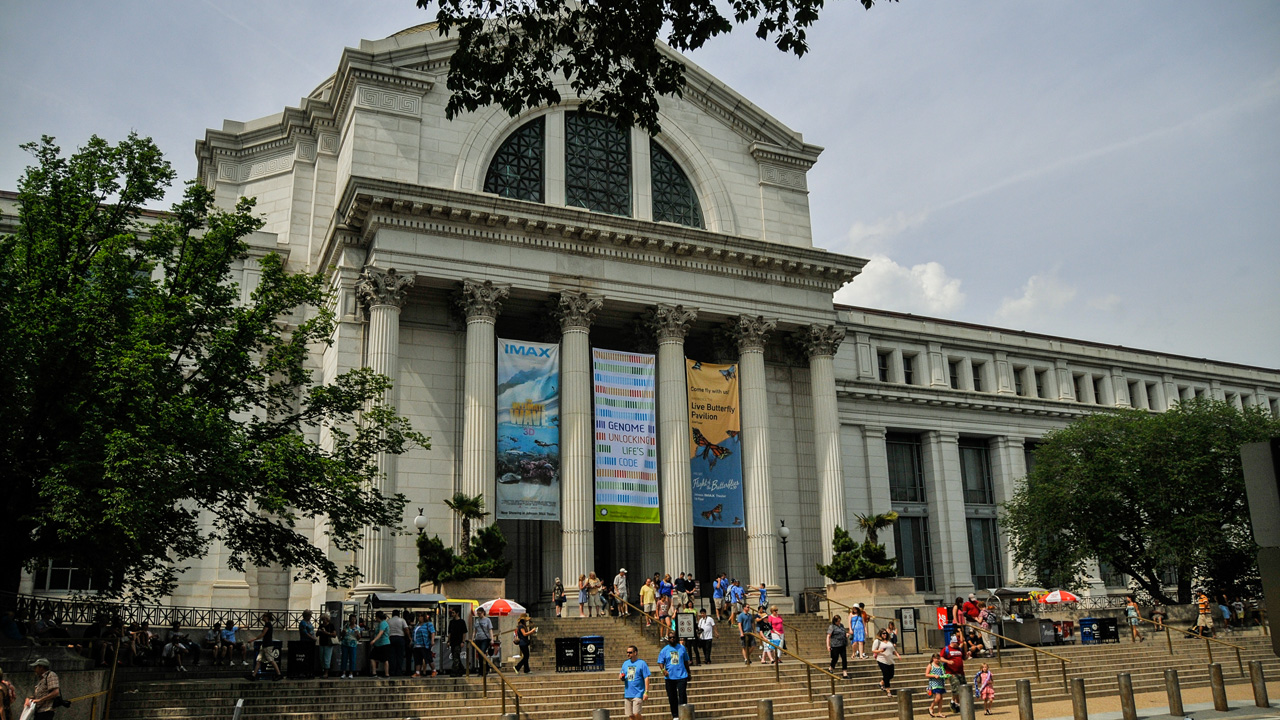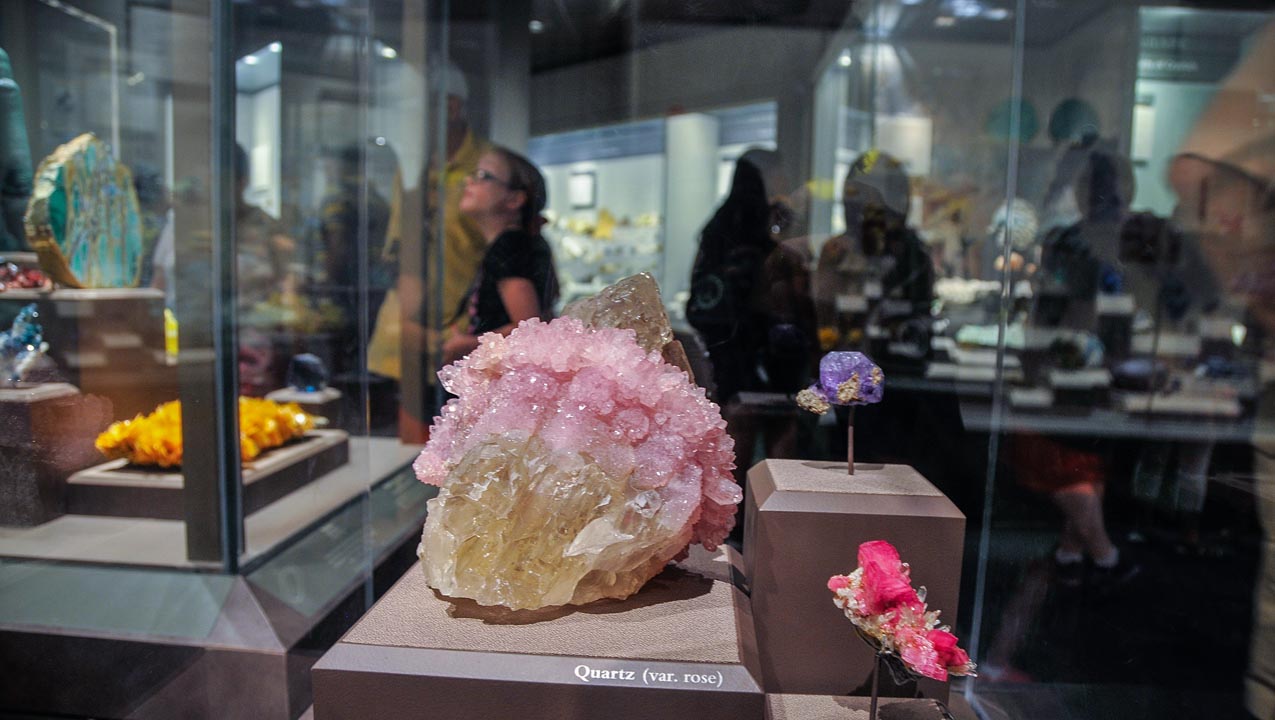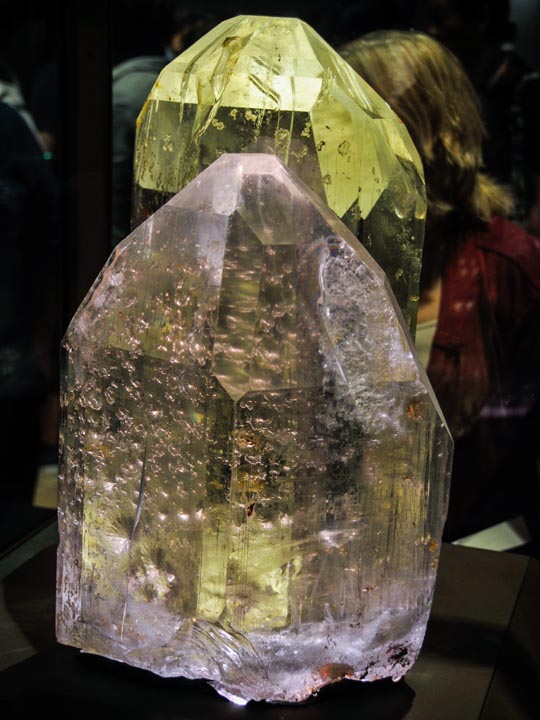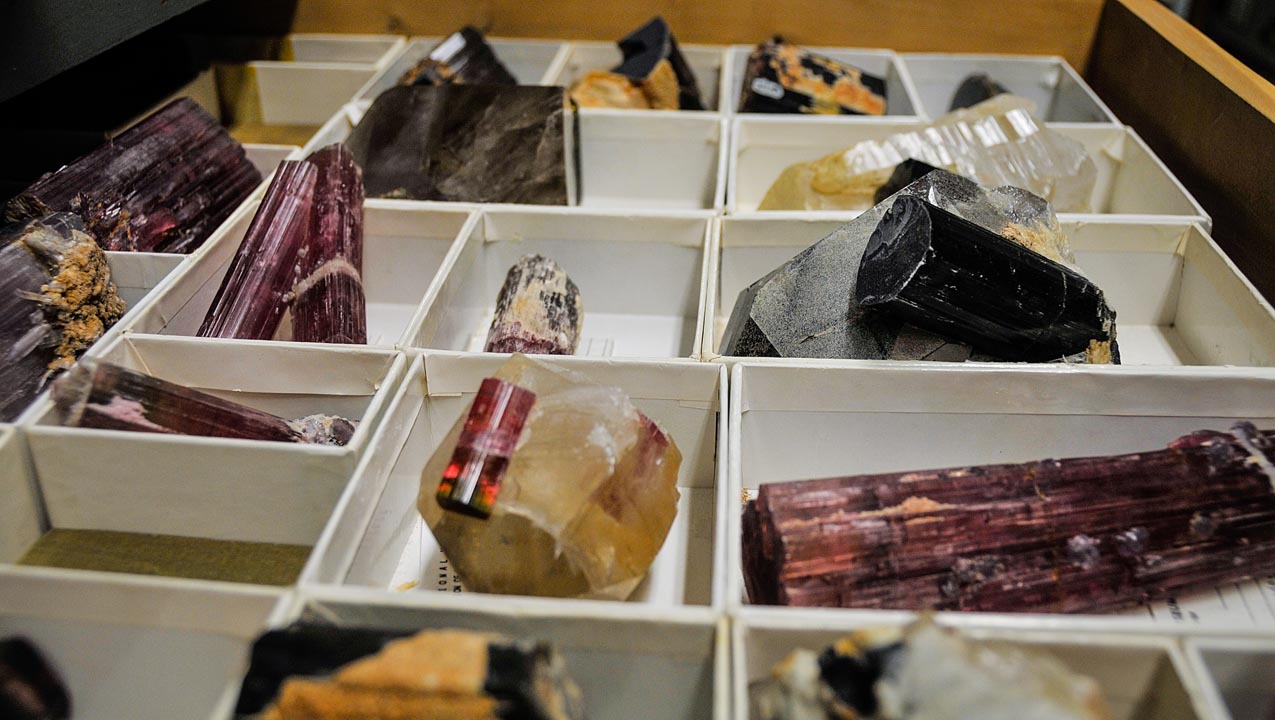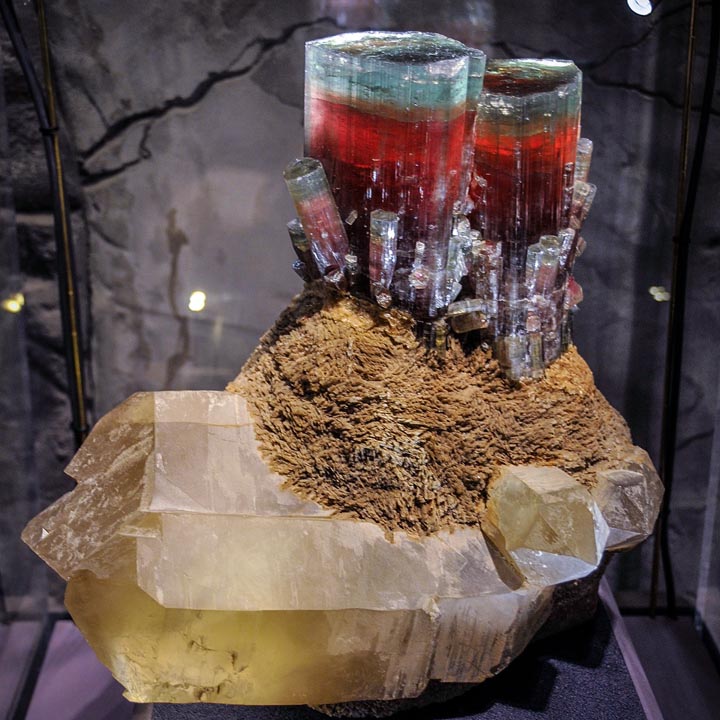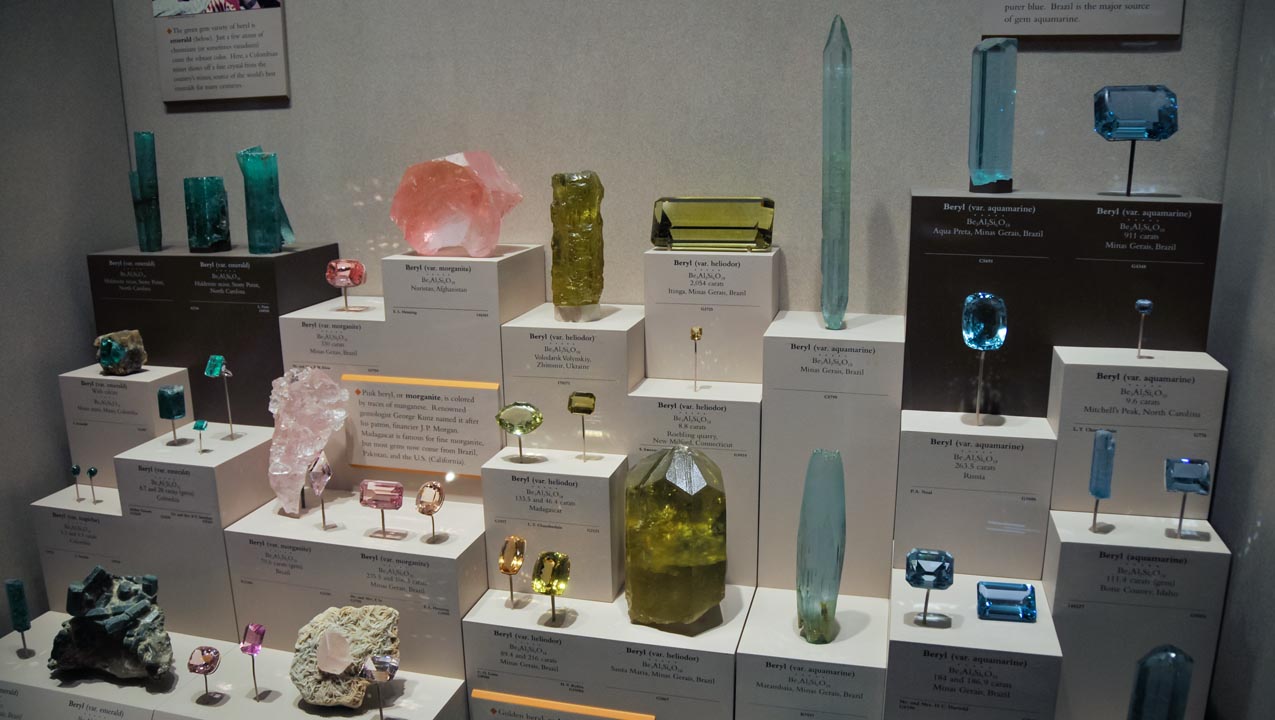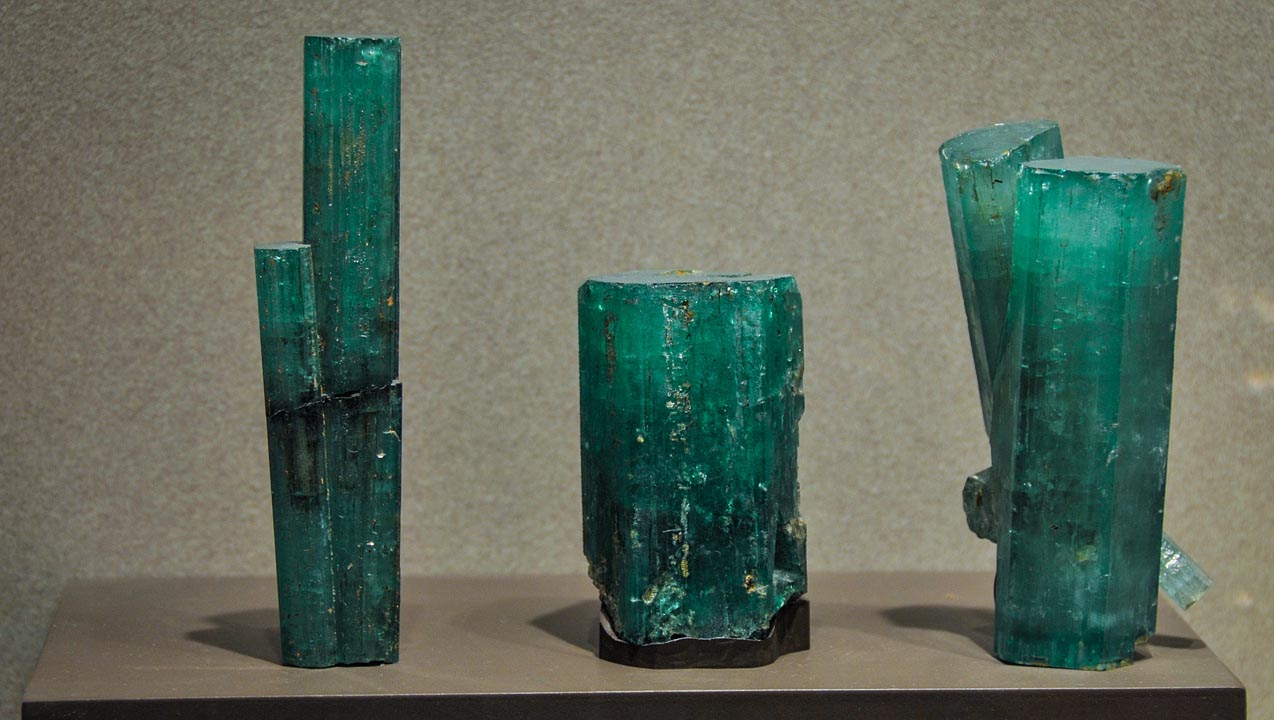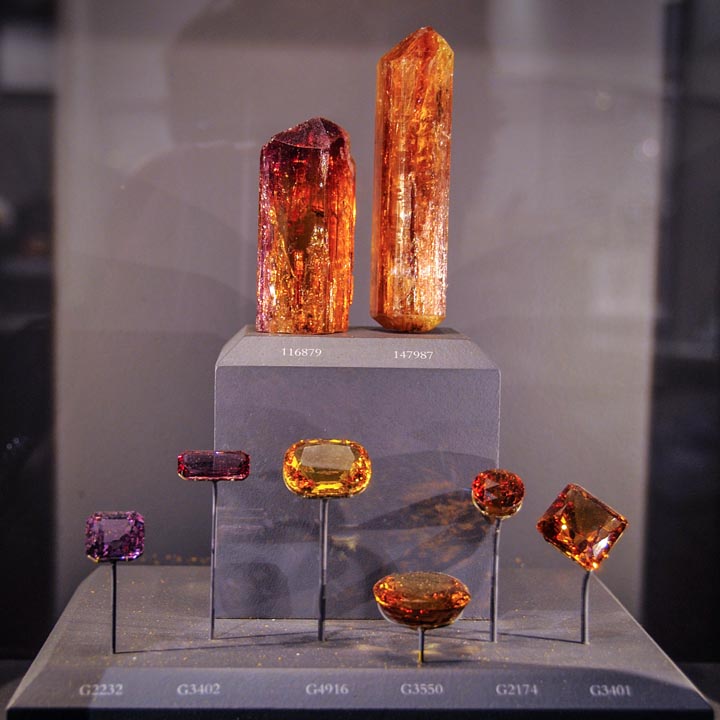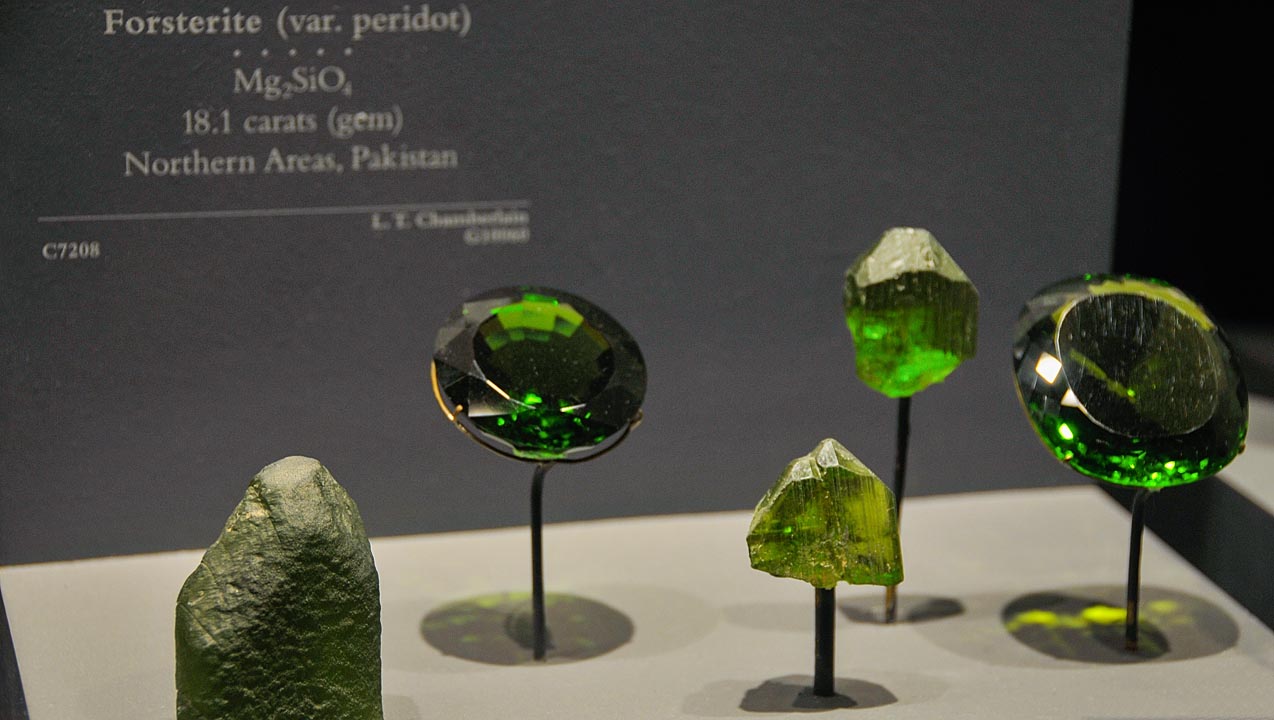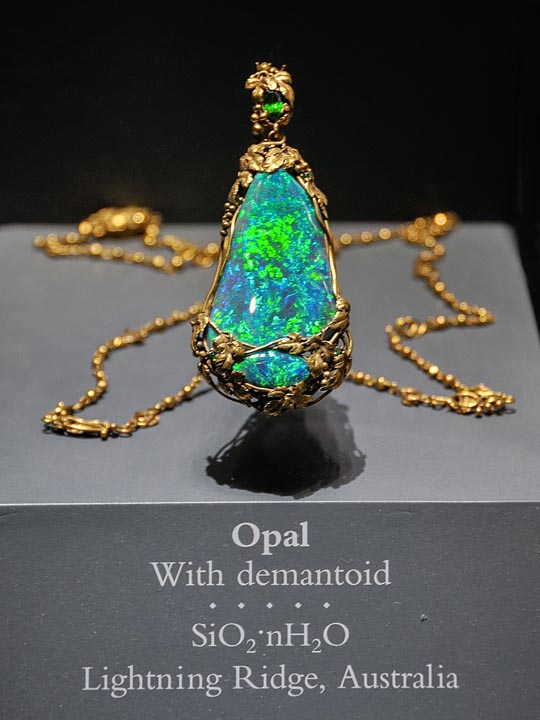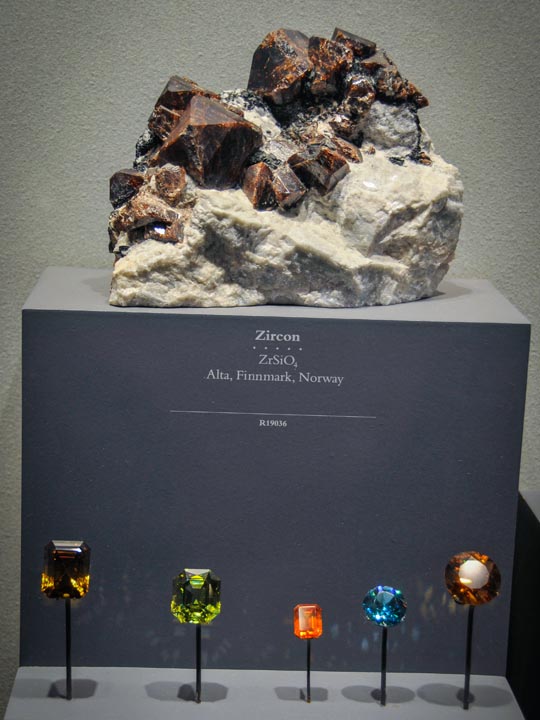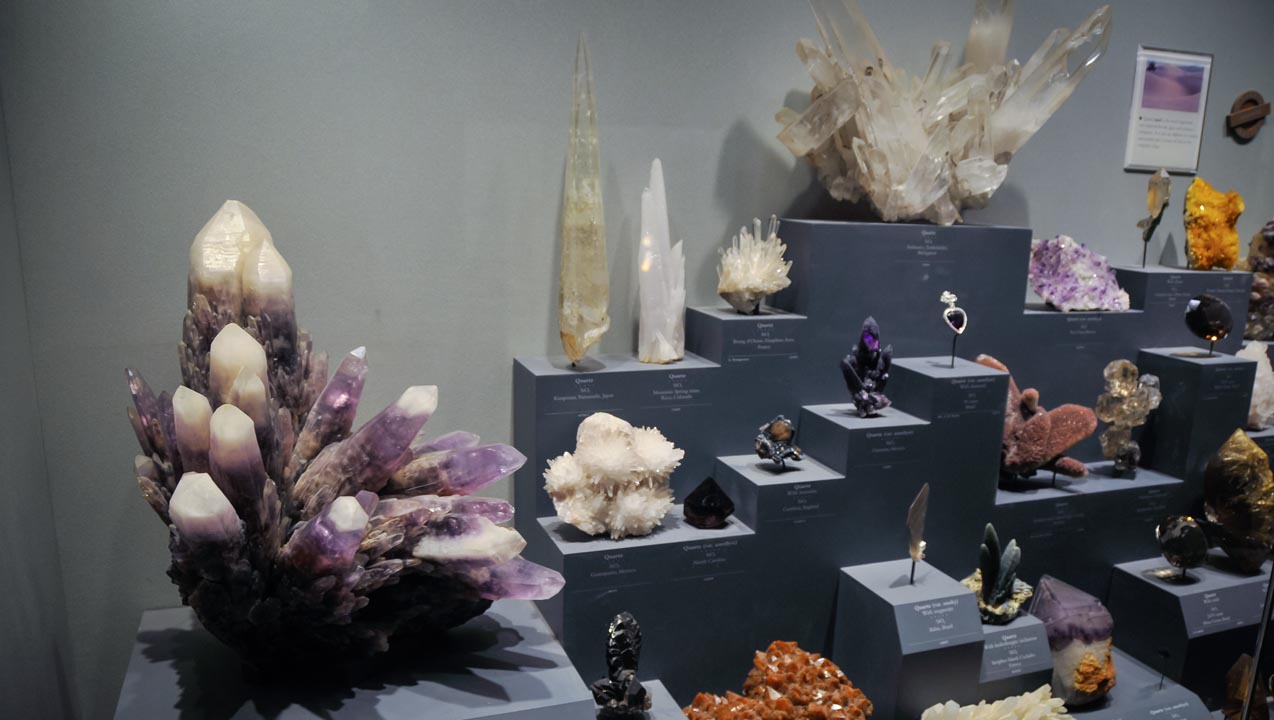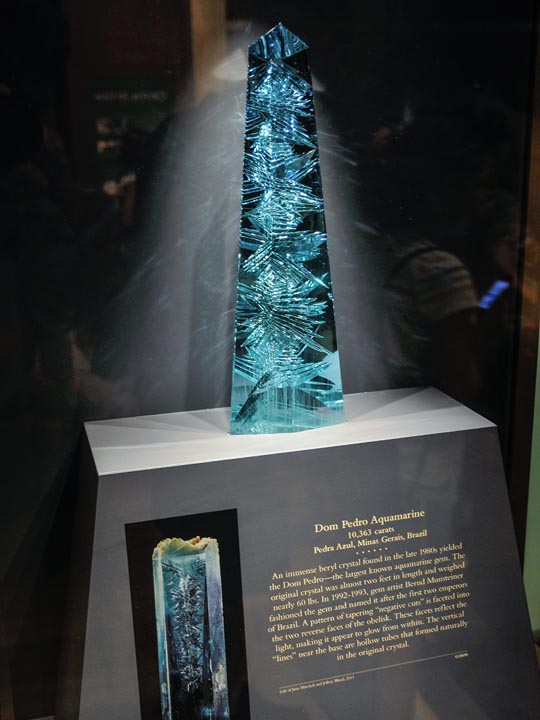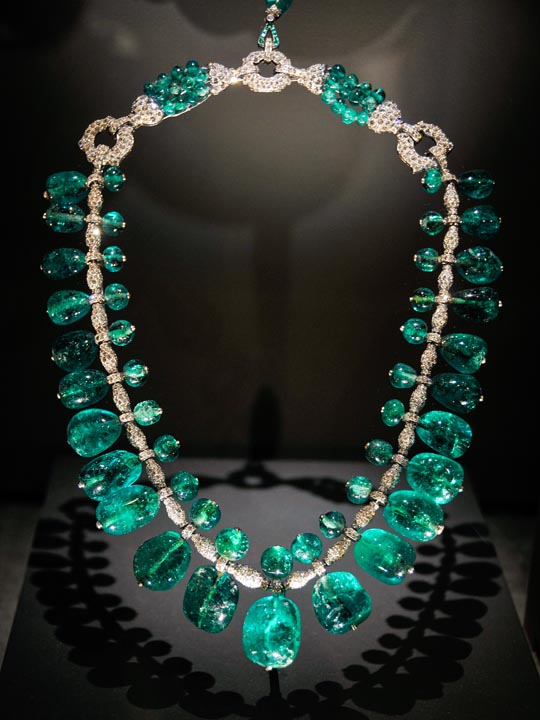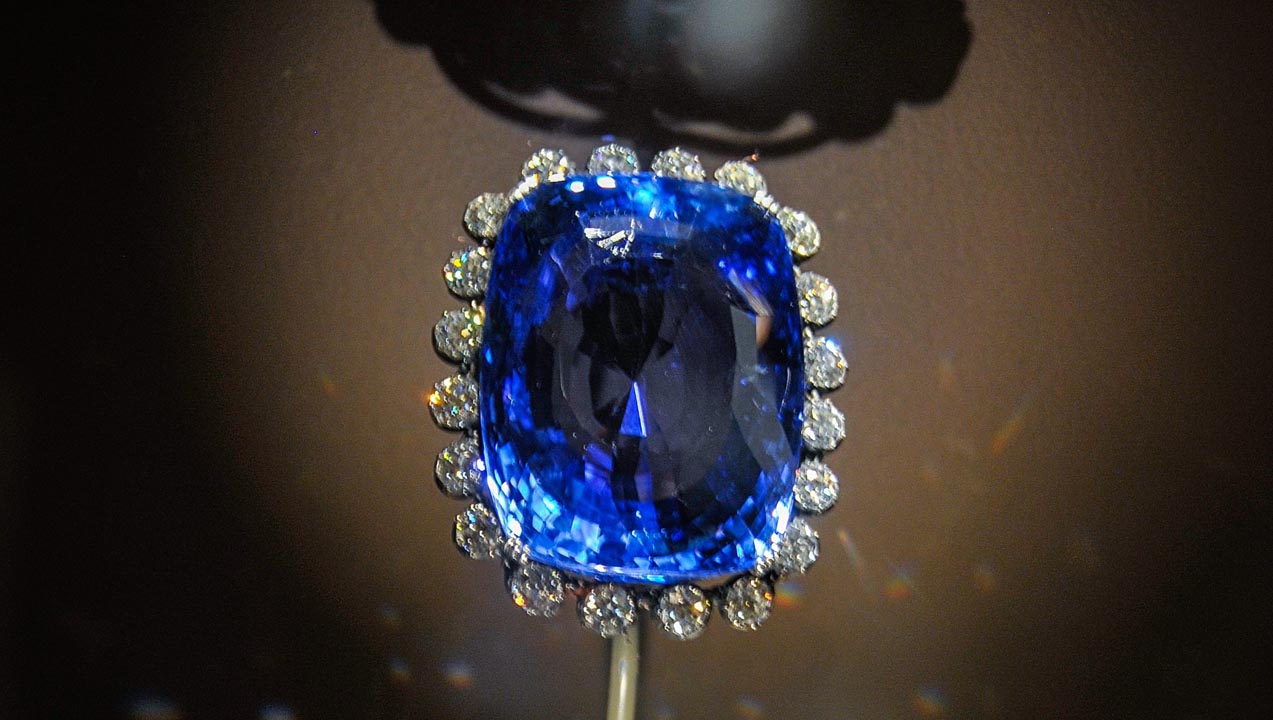The Smithsonian Gem and Mineral Collection
November 14, 2013
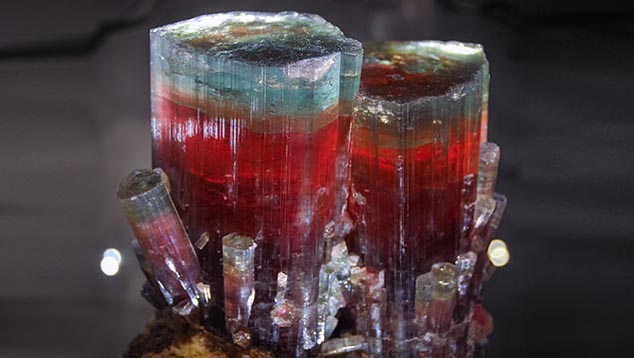
It’s what the museum’s curator, Jeffrey Post, Ph.D., calls a “teaching moment” for a lot of people. That’s the goal, he says—for people “to have that exciting moment, to think about the earth in a different way.”
Earth’s Treasures
Join curator Jeff Post as he introduces some of the Smithsonian’s gem and mineral treasures.
In early 2013, Dr. Post hosted a team from the Gemological Institute of America’s (GIA) Carlsbad, California, campus. This series of videos documents that visit and gives you an intimate view of the museum’s public displays and scientific research collections.
This slideshow takes you on a tour of the Smithsonian and its gem treasures.
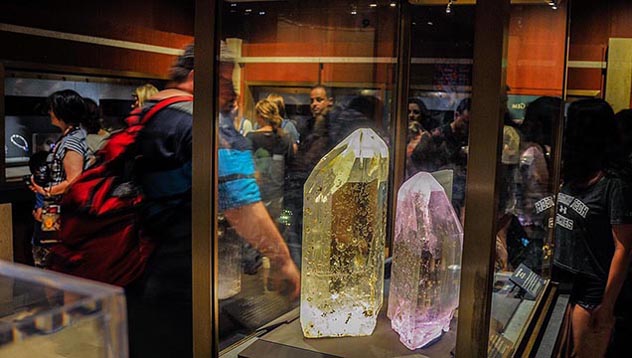
In the Janet Annenberg Hooker Hall of Geology, Gems, and Minerals, the geometry and size of these topaz crystals capture visitors’ attention. Photo by Duncan Pay © GIA, courtesy The Smithsonian Institution http://geogallery.si.edu
THE SMITHSONIAN
The Smithsonian Institution is the world’s largest museum and research complex. Located on the National Mall in Washington, D.C., the complex includes 19 museums and galleries, the National Zoological Park, and nine research facilities.The Institution’s original funding came in the form of a bequest to the US federal government, established by British scientist James Smithson (1765-1829) and awarded upon his death. In 1836, his legacy—with a value at the time of about $500,000—was officially accepted by Congress. After additional years of debate, the Smithsonian Institution was finally established in 1846 as a trust to be administered by a Board of Regents and a Secretary of the Smithsonian.
Today, the National Museum of Natural History is part of that vast complex. It opened in 1910 and houses exhibits that encompass the animal kingdom, human origins, world cultures, and the earth sciences.
Tucked into the eastern wing of the museum’s second floor is the Janet Annenberg Hooker Hall of Geology, Gems, and Minerals. Dedicated to the earth sciences, it houses one of the world’s largest gem and mineral collections, including such world-famous gems as the Hope diamond, Logan sapphire, and Rosser Reeves star ruby, along with countless thousands of less-famous but equally spectacular gem and mineral specimens.
Directly behind the public display area is the mineral research wing, where the GIA team was allowed unprecedented access to this national treasure.
THE MINERAL REFERENCE COLLECTION
The museum’s mineral reference collection is one of three in the Department of Mineral Sciences: minerals (including gems), meteorites, and rock and ore. Dr. Post explains that this part of the museum deals with the “hard, non-living part of the earth…A small oasis of mineral sciences in a large sea of biology” within the museum. But, he adds, “since the earth is mostly made up of rock, we understand the importance of our role here.”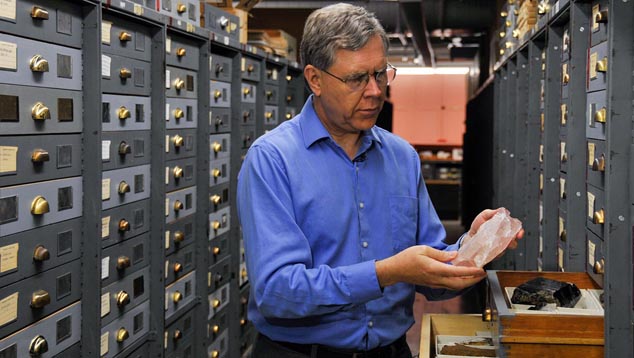
Smithsonian curator-in-charge Jeffrey Post explains the Smithsonian’s mineral storage and cataloguing system. Photo by Duncan Pay © GIA, courtesy The Smithsonian Institution http://geogallery.si.edu
The research collection houses about 375,000 mineral specimens from around the world. It’s one of the largest collections of its kind, with great value to the scientific community. The purpose of the collection is to support scientific research. All specimens are available for use by researchers around the world, who either come to the museum or have specimens sent to them. Some of the Smithsonian’s own researchers also work in the Institution’s laboratories.The minerals are arranged according to the Dana System, which classifies minerals into numbered categories based on chemical composition and crystal structure. The system was originally developed by James Dwight Dana (1813-1895), an American geologist and mineralogist. He outlined the original concept in his System of Mineralogy (1837). In 1997, the work was updated by a team of mineralogists to accommodate newly discovered materials and retitled Dana’s New Mineralogy, Eighth Edition.
The Smithsonian’s minerals are arranged in long banks of drawers, with all similar kinds of minerals grouped together. He points to the drawers in front of him, where quartz specimens are arranged alphabetically by locality.
Each specimen has a number that’s keyed to a computerized database, where they can find information about the specimen and also keep track of its location. If a researcher is interested in studying a particular mineral, museum staffers take a chip off the larger specimen and give or send it to the researcher, with the agreement that the researcher will then share the results of his or her study with the museum. This information is added back into that specimen’s database. Any scientist in the world has access to the reference collection as long as they’re connected to a legitimate research organization.
A World-class Resource
Curator Jeff Post introduces the Smithsonian’s mineral reference collection and explains its value to the world’s scientists.
ORGANIZING THE COLLECTION
Arrangement according to the Dana System means all similar kinds of minerals are found together, making it very accessible for scientists. “Not very good for the public,” Dr. Post observes, “but good for scientists.”As he explains the collection’s layout, he’s standing in front of the beryls: “One of the more dramatic silicates in terms of crystals and colors.”
He has his assistant pull out a few beryl drawers. They hold a wonderful variety of crystal sizes and shapes and all the colors that make beryl so popular: blue-green aquamarines, pink morganites, green emeralds, gold-colored heliodors. Each specimen has a box and its own number, which is keyed to the collection’s computerized database.
The beryls are arranged alphabetically by where they came from. In the first drawer are the A’s and B’s—places like Afghanistan and Brazil; the next drawer includes Burma, California, Colombia; then a drawer with beryls from Colorado, Ireland, Italy, Mozambique, and Namibia. He points out that the alphabetical arrangement accommodates a mixture of states and countries.
Later, when asked about the possibility of different mineral types growing together, he takes out a large, spectacular specimen from a fairly new locality—Erongo, in Namibia. It’s studded with beautiful aquamarine crystals and two varieties of tourmaline, all embedded in a matrix of white albite for striking contrast.
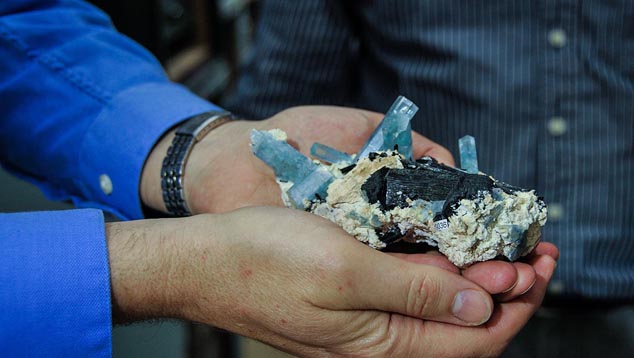
This specimen is a combination of aquamarine and tourmaline in albite. It’s from Erongo, Namibia, and is a superb example of how different mineral species can grow together. Photo by Duncan Pay © GIA, courtesy The Smithsonian Institution http://geogallery.si.edu
Dr. Post states that the advantage of the national research collection is that it will always be there, so that hundreds of years in the future, a scientist can re-study a sample of the same specimen studied by his centuries-earlier counterpart. This makes it the standard mineral collection for the international scientific community, available to present and future generations of scientists.
Organizing Minerals
Curator Jeff Post takes us through areas of the museum’s mineral collection and explains how its logical organization benefits scientists.
IN THE BLUE ROOM
The collection’s main secure storage area, which they call the Blue Room, is where they store the more high-value portions of the mineral collection. The Blue Room and the nearby Gem Vault contain about 20,000 mineral specimens. This area is the source of most of the pieces selected for public display. It also serves as an acquisition area: As new specimens come in, they’re placed in a secure work area for unpacking and classification.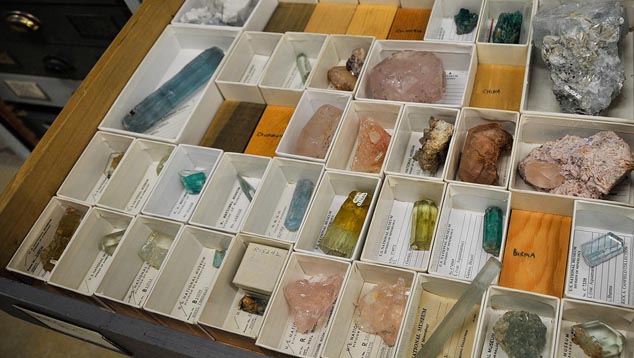
This drawer is one of many in the gem collection’s Blue Room. It contains beryl specimens from localities all over the world. Photo by Duncan Pay © GIA, courtesy The Smithsonian Institution http://geogallery.si.edu
Dr. Post explains that visitors to the exhibits have some idea where gems come from, but don’t always make the connection all the way back to the earth. However, when they walk into the galleries and see the beautifully formed crystals and extraordinary colors of the exhibit’s mineral specimens, they experience what he calls “a-ha moments.”To illustrate, he cradles a spectacular specimen from Zambia—multiple emerald crystals still embedded in their surrounding matrix. “A specimen like this one,” he says, “really helps (people) make that connection.”
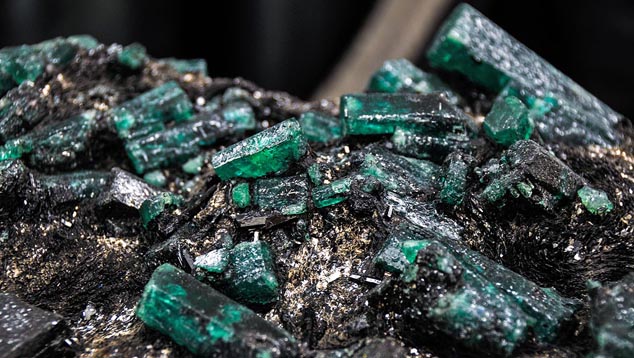
Zambian emeralds glitter against a backdrop of coal-black mica in this superb mineral specimen. It’s one of the Institution’s most recent acquisitions. Photo by Duncan Pay © GIA, courtesy The Smithsonian Institution http://geogallery.si.edu
As an aside, he mentions that it was purchased for the Smithsonian by a member of the Smithsonian Gemstone Collectors, an elite support group that helps with financial support as well as acquisition of spectacular specimens like the one he’s holding.IN THE GEM VAULT
Around the corner from the Blue Room is the Gem Vault, where they store high-value specimens and new arrivals under highly secure conditions.He shows off a fairly new addition to the collection: a magnificent platinum and diamond necklace with a fascinating emerald carving as its centerpiece. It was willed to the museum by Madeleine Murdock, a New Jersey resident. The emerald itself weighs about 100 carats. What’s unique and unusual about it is that it’s a slice, a cross-section through an emerald crystal that still possesses the six-sided outline of the crystal’s original hexagonal shape. Its magnificent color is zoned from light-toned in the center to a darker green along the outer surface.
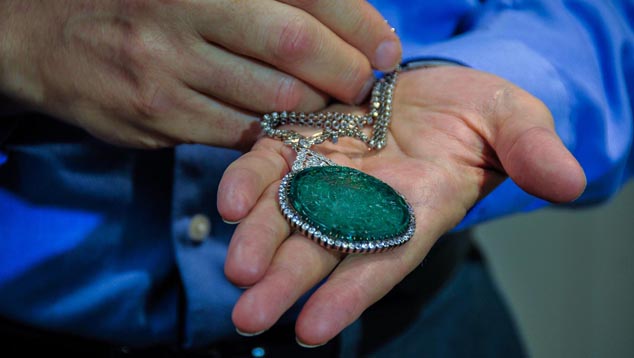
This historic carved emerald is set into a platinum, gold, and diamond necklace. Possibly acquired in Colombia by Spanish conquistadors, the emerald was carved in the Mogul style, then set into the pendant and necklace in France around the turn of the 20th century. It was donated by Madeleine H. Murdock in 2007. Photo by Duncan Pay © GIA, courtesy The Smithsonian Institution http://geogallery.si.edu
Based on its characteristic inclusions, museum researchers identified Colombia as its source. From there, it was probably shipped to India in the 1600s, where the Mogul rulers were particularly fond of emeralds from the New World. Its lotus-blossom motif was carved soon after its arrival in India. Two small drill-holes through the sides mean it was originally meant to be sewn onto cloth or ribbon as an amulet or garment decoration.Markings on the setting indicate that the emerald carving eventually made its way from India to Paris in the 1920s, during the Art Deco period. In Paris, it was reset into a magnificent platinum and diamond setting. Eventually, it made its way to Mrs. Murdock’s collection. Dr. Post cites it as a wonderful example of an emerald moving around the world: from Colombia, to India, to Paris, to New Jersey, and finally to Washington, DC.
Historic Emerald Pendant
Jeff Post shows off one of the museum’s recently acquired treasures: a magnificent emerald pendant with a fascinating history.
Showing another specimen from the Gem Vault collection, Dr. Post holds a nondescript object that looks something like a small brown rock. It’s from an opal-mining area near a small town called Yowah in Queensland, Australia. He describes it as “a curious-looking object” that locals call a Yowah Nut. Of course, it’s not a nut—it’s actually an ironstone concretion. When miners break one open, they sometimes find opal inside.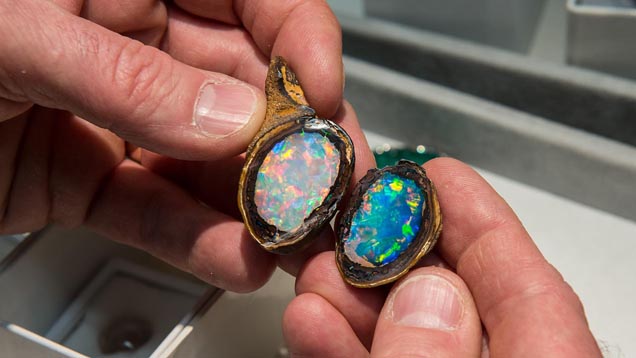
This unique Yowah Nut opal is divided so one side has the appearance of a black opal, while the other side appears lighter. Both sides feature beautiful play-of-color. Photo © Eric Welch, courtesy The Smithsonian Institution http://geogallery.si.edu
This one, first presented to Dr. Post by a particularly enthusiastic opal miner, was cracked open to reveal an especially beautiful opal interior. The “nut” was not cut exactly down the center, so the thinner layer—with its dark mineral background—shows a deep blue color, while the thicker layer has a more typical white opal appearance. Both sides display dazzling play-of-color. The miner called it his “OMG opal” because every time he opened it up to show someone, they’d exclaim “Oh my gosh!!” Thanks to one of the museum’s generous donors, it later became part of the museum’s collection.Dr. Post enthuses that this falls in the category of “…when you think you’ve seen everything…”
“It reminds you that earth is a pretty amazing place and we haven’t seen everything yet…It’s one of nature’s really nice little surprises.” He also observes: “It’s not always the value of the object, it’s the sense of surprise…of something different. That’s one of the reasons we like things like this. We like to jar people out of their normal way of thinking a little bit.”
Yowah Nut Opal
An unpromising nugget opens to reveal a hidden interior: a beautiful opal with spectacular play-of-color. Curator Jeff Post explains how this opal miner’s find-of-a-lifetime came to be in the museum’s collection.
As Dr. Post tells it, the purpose of the Smithsonian’s public gem and mineral display, as well as its research collection, is to make people aware of how fascinating the earth really is. Inspired by that philosophy, Dr. Post and his staff have designed a vast and deep collection of the earth’s wonders and opened them up for all of the world to see.
ABOUT THE AUTHORS
Merilee Chapin is managing editor, Duncan Pay is editor-in-chief of Gems & Gemology, and Pedro Padua is a video producer at GIA content development in Carlsbad, California. Dr. Jim Shigley is a distinguished research fellow at GIA’s Laboratory in Carlsbad.
ACKNOWLEDGMENTS
The authors would like to thank Dr. Jeffrey Post, curator of the National Gem and Mineral Collection, and Russell Feather, museum specialist, both at the Smithsonian Museum of Natural History in Washington D.C., for their help and courtesy during our visit.
